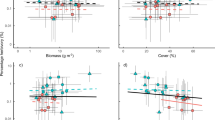Abstract
We provide evidence for a mechanism by which herbivores may influence plant abundance in arctic ecosystems. These systems are commonly dominated by mosses, the thickness of which influences the amount of heat reaching the soil surface. Herbivores can reduce the thickness of the moss layer by means of trampling and consumption. Exclusion of grazing by barnacle geese and reindeer over a period of 7 years at Ny-Ålesund, Spitsbergen, caused an increase in the thickness of the moss layer, and a reduction in soil temperature of 0.9 °C. Soil temperature was negatively correlated with moss-layer thickness across sites, with highest soil temperatures where moss layers were shallow. We found that moss growth did not respond to experimental manipulation of soil temperature, but the grass Poa arctica (arctic meadow-grass) and the dicot Cardamine nymanii (polar cress) suffered a 50% reduction in biomass when growing in chilled soils.
Similar content being viewed by others
Author information
Authors and Affiliations
Additional information
Accepted: 17 April 2000
Rights and permissions
About this article
Cite this article
van der Wal, R., van Lieshout, S. & Loonen, M. Herbivore impact on moss depth, soil temperature and arctic plant growth. Polar Biol 24, 29–32 (2001). https://doi.org/10.1007/s003000000170
Issue Date:
DOI: https://doi.org/10.1007/s003000000170




